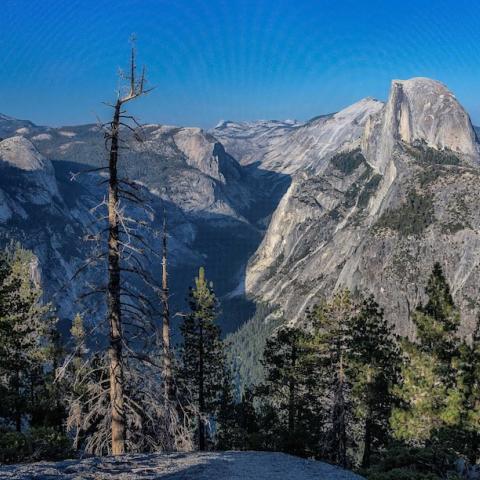Editor's note: The following article on maps of the National Park System was written by Alex Demas and Mark Newall of the USGS.
The national parks of the United States are often compared to, and indeed inspire, works of art. In fact, the USGS has been regularly contributing new and updated works of art for the national parks—maps.
USGS maps in national parks serve a variety of purposes, from planning to hiking to scientific interest. From outer space or beneath the water’s surface, here are some of the masterpieces of USGS maps in the national parks:
Topographic Maps
Probably the most famous maps of the national parks are the USGS topographic maps. Topographic maps show the elevation of various features in a landscape, such as the height of hills or the depth of valleys.

In this map section, the elevation of Acadia National Park’s Cadillac Mountain can be seen.
The USGS has been producing topographic maps since its founding in 1879. As mapping techniques improved, updated maps have been issued. The USGS recently unveiled a repository for all of its historical topographic maps at USGS TopoView.

Left: Yellowstone National Park topographic map from 1983. Right: Yellowstone National Park topographic map from nearly a century before, in 1885.
Topographic maps have had a great many uses for the national parks. Any large-scale geographic development relies on topographic maps to accurately plan where improvements will go. Famous roads in the national parks, such as Shenandoah’s Skyline Drive or Glacier’s Going-to-the-Sun Road would not have been as successful without accurate topographic maps.

A topographic map showing the Skyline Drive in Shenandoah National Park.
Another important use for these maps is for hikers, who rely on these maps for trail conditions and keeping track of where they are. The national parks have thousands of miles of trails, and USGS topographic maps are a key tool for not getting lost.

A map of several trails in Rocky Mountain National Park.
National Scenic Trails
As a subset of the topographic maps of national parks, the USGS is hard at work on adding all of the National Scenic Trails to The National Map Products. National scenic trails are those trails that are set aside for their particular national beauty. There are 11 national scenic trails covering parts of at least 32 states.
The most famous is probably the Appalachian National Scenic Trail, which extends some 2,200 miles from Springer Mountain in Georgia to Mount Katahdin in Maine.
The longest of the national scenic trails is the North Country National Scenic Trail, which stretches about 4,600 miles from Crowne Point in New York to Lake Sakakawea State Park in North Dakota.

This map shows the John Muir National Scenic Trail in Sequoia and Kings Canyon National Parks.
The USGS started adding the national scenic trails at the start of 2014, and although not all states are covered yet, USGS cartographers are working on getting them added as quickly as possible. Those areas that are covered are best viewed on the US Topo maps and can be downloaded here in GeoPDF form.
Geologic Maps
Another type of map that the USGS has provided the National Park Service with is geologic maps. These maps show the geologic formations and deposits in a region.

Geologic Map of Big Bend National Park
Geologic maps can serve many purposes. The types of rock formations in an area can affect many things, from water availability, ecosystem vulnerability, and even human health. For instance, certain rock formations have high amounts of heavy metals that, if they leach into streams or other water sources, can negatively impact both ecosystem health and human health if people drink the water.
Just like with topographic mapping, geologic mapping has advanced through the years too. Modern remote sensing tools allow for subsurface imaging that was not previously possible. Images like the one below can show both the geologic history of an area and even tectonic faulting, which can produce seismic activity:
Remote Sensing
USGS maps in the national parks are not limited to ground-level or subterranean areas. They can also be conducted remotely, via tools like airborne lidar or satellite imagery.
Lidar, which stands for light detection and ranging, is a tool normally used for elevation information, such as in the topographic maps mentioned previously. However, USGS research has also allowed it to be used to map vegetation density in sensitive ecosystems.
Mapping vegetation density is important to park managers, because it is one measure of ecosystem health. In the Barataria Preserve of Jean Lafitte National Historical Park of Louisiana, the delicate coastal marshes are threatened by coastal erosion. Accurate mapping of the vegetation density allows park managers to keep tabs on the health of the marsh.
Remote sensing maps of national parks can even be conducted from satellites. The Landsat satellite, operated by the USGS and NASA, regularly provides maps of the national parks as it orbits overhead. These maps can provide critical services to park managers, especially during forest fires.

A Landsat image of wildfire in Yosemite National Park in August of 2013.
Landsat maps can not only help fire fighters track fire as it spreads across the national parks, but also aid scientists’ understanding of how the land recovers.
Start with Science
As the National Park Service celebrates 100 years of managing the Nation’s Crown Jewels, the USGS will continue to provide the best maps forward for the next 100 years and beyond.









 Support Essential Coverage of Essential Places
Support Essential Coverage of Essential Places







Comments
USGS historic topo maps are treasures for searching for the hundreds of miles of historic trails abandoned by NPS in each of the major national parks. Alas, USGS topoView includes only historic topo quadrangles, and none of the series of National Park topo maps which NPS has produced over the past century.